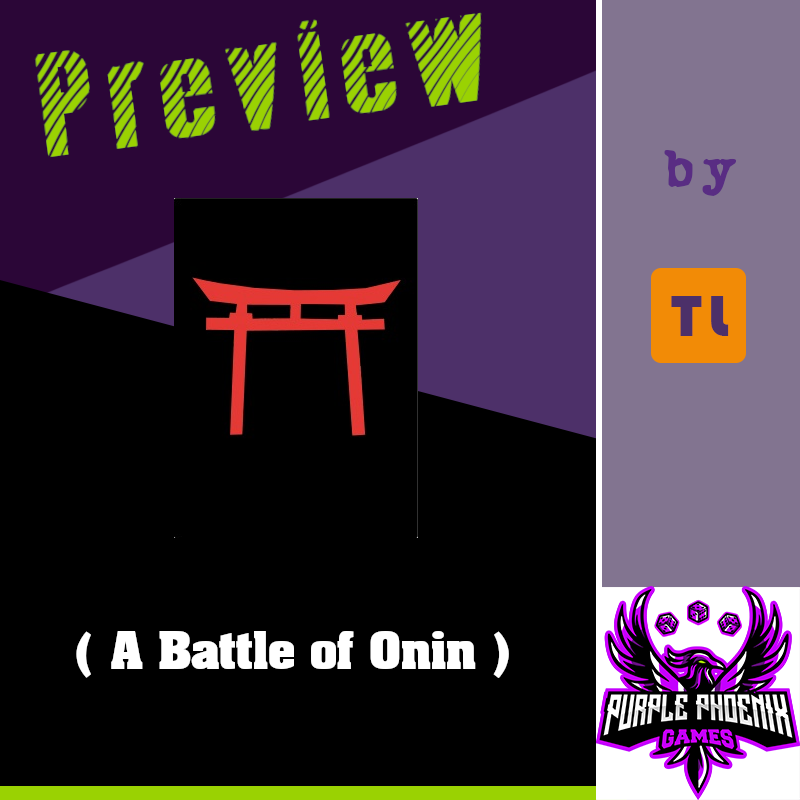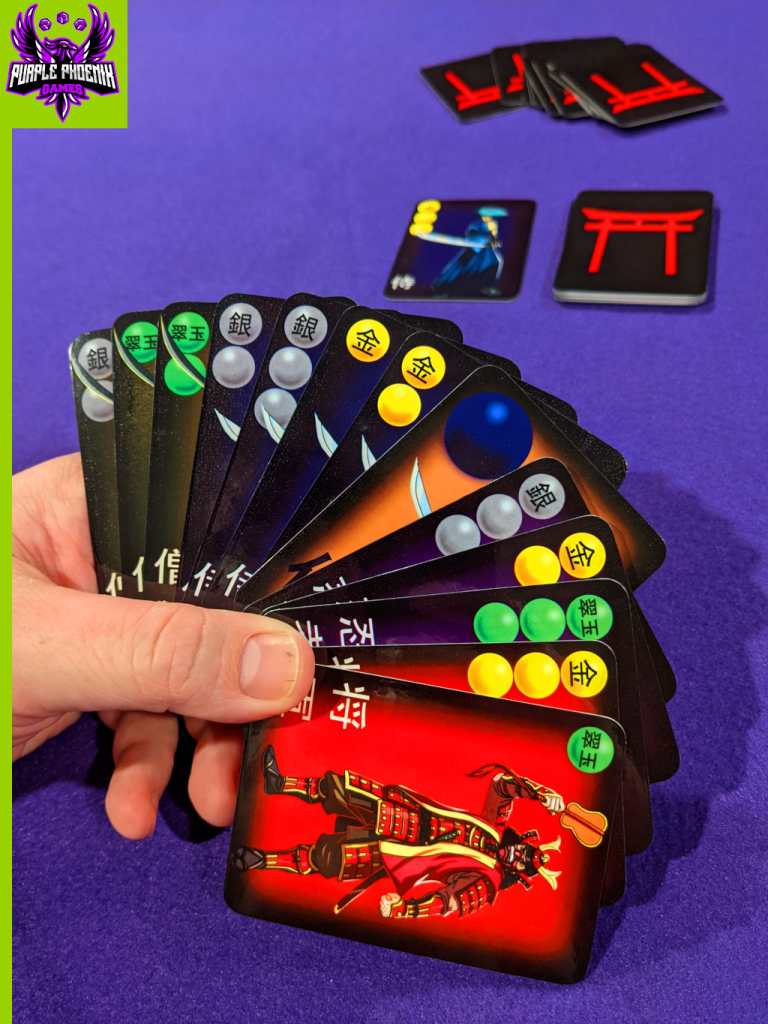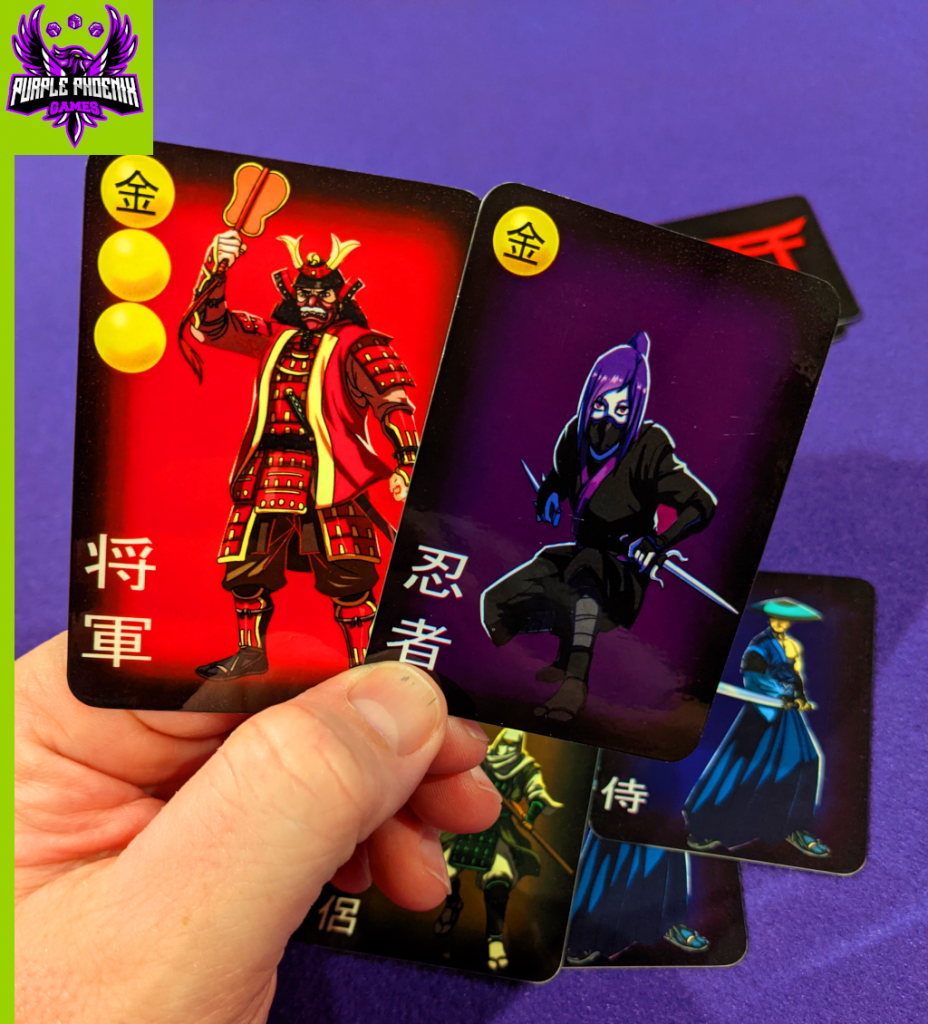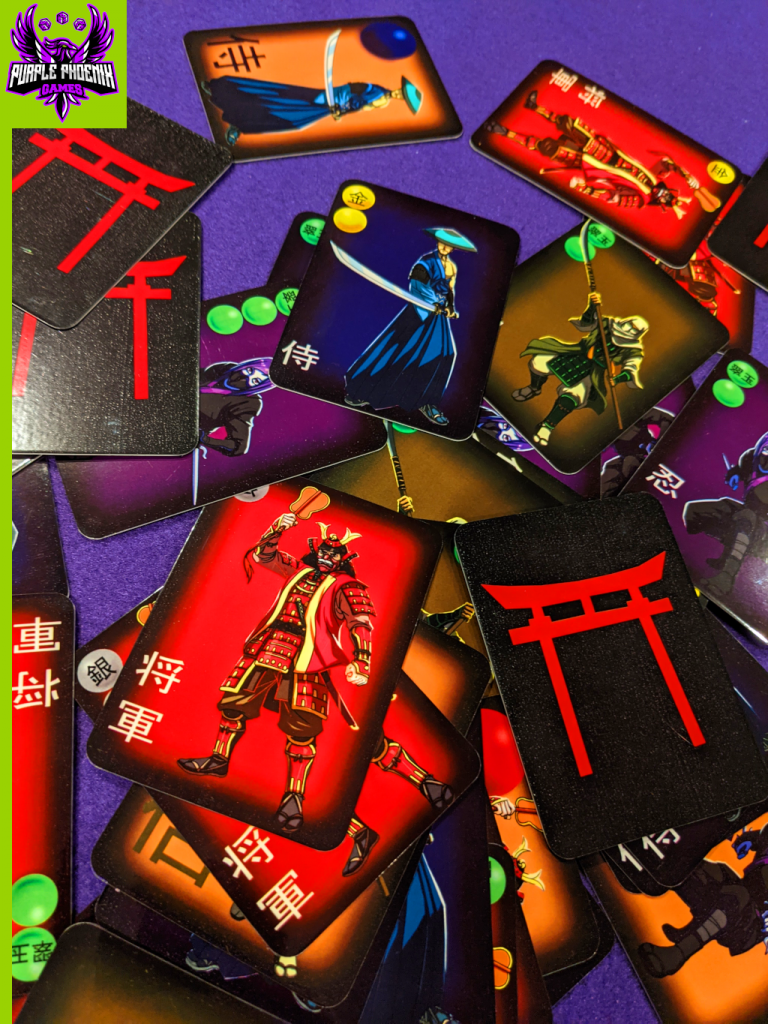
I am a big fan of Asian culture and board game theming. Now, I am not at all versed in Anime, nor am I an aficionado. I just enjoy Asian people, history, cultures, food, and board game themes. That said, when I learned of A Battle for Onin I knew I wanted to take a look at it, being as it was touted as familiar mechanics with an Asian theme. So how does it play?
| A Battle for Onin (2021) | Guise Gaming |
| 2-5 Players | 30-60 minutes |
| Ages 10+ | BGG Weight – (not yet available) |
A Battle for Onin is a trick-taking card game where players will be using Shoguns, Ninjas, Samurai, and Monks as suits and each suit will have differing levels of hierarchy. The first player to earn 35 total influence (VP) will claim victory.
DISCLAIMER: We were provided a prototype copy of this game for the purposes of this review. These are preview copy components, and I do not know for sure if the final components will be any different from these shown. Also, it is not my intention to detail every rule in the game, as there are just too many. You are invited to download the rulebook, back the game through the Kickstarter campaign, or through any retailers stocking it after fulfillment. -T
To setup shuffle the deck of cards and deal each player 13 cards. The dealer then flips the top card of the deck and becomes the Ruling Class (trump) for the hand. The game is now setup and ready to begin!

After the Ruling Class has been revealed, the player left of the dealer will make a bid for how many Conscriptions (tricks) they believe they will take in the round, with a minimum bid of 3 tricks for all players. Each other player will do the same until the leading player’s turn comes back around. That player then proceeds to play cards from hand in attempt to win tricks. Like in most trick-taking games player will need to follow the suit that was led (or flipped at the beginning of the round). A twist here is that trump may not be led until it has been used to win a trick previously within the round.
As mentioned earlier, each suit has a hierarchy of power, where Bronze is the lowest in power increasing to Silver, then to Gold, and finally to Jade. Within these divisions are yet three more classifications of power: one sphere (lowest) to three spheres (most powerful). In addition still is one card from each suit whose background is orange in color and features one large sphere. These are the Legendary cards, and the most powerful of each suit. Legendary cards may be used as the highest-ranking card in their suit, or as a Ruling Class card. When played as Ruling Class (trump) the hierarchy of Legendary cards are as follows: Monk (lowest), Samurai, Ninja, Shogun (most powerful).
Play continues with players using their cards to win Conscriptions (tricks) and meet their bid. Should a player meet their bid exactly then they score Influence (VP) for their tricks won. Should a player win more tricks than bid earlier, they still score Influence for the tricks won, but those tricks in excess of the bid amount are scored also as Corruption. When a player meets seven Corruption they immediately lose 10 Influence and the Corruption counter resets for that player. If, by chance, a player does not meet the mandatory bid of three tricks, their Influence is lowered by one point. However, should a player bid higher than the minimum of three but not meet that bid their score will be reduced by the amount of the bid for the round (example: a player bids seven tricks but earns only five. They reduce their Influence by seven points – ouch).
Once scores are tallied at the end of each round, a winner may be announced if they score at least 35 points. If no winner is crowned this round, a new dealer is assumed and another round setup as at the start of the game.

Components. Again, this is a prototype copy of the game and this copy is actually hand-made by the good people at Guise Gaming. Each card in this copy is laminated and the game box is HAND PAINTED. I have never received a hand painted box before, and it is certainly appreciated. So aside from the non-manufactured components, the art is quite good on the cards. I know some players will have issues with the backgrounds seeming plain, but I quite appreciate it so that I can concentrate on the game and not be overly distracted by what may be happening in the backgrounds.
Gameplay is good, if not a bit confusing at first. With four different suits containing essentially the standard 13 cards per suit it should be an easy no-brainer to keep things squared away. However, I found that having the rule booklet open to the page detailing the hierarchy of sphere color/material was very handy for other players. The Legendary cards are easy to distinguish because they look cool and different from all the other cards. I really know nothing about any Asian language, so the characters (or letters/words) depicted on the cards are of no help to me trying to distinguish power levels.
That said, when contacted by the publisher about A Battle of Onin, they mentioned that other people were calling it a theming of Spades. While I can understand this simplification, what I have yet to mention is that the game also comes with a bevvy of optional scoring rules and a welcoming message to include any sort of house rules deemed enjoyable. Spades does not do that, to my knowledge. While the vanilla gameplay is very similar to Spades, A Battle of Onin using any of these optional scoring modes certainly adds layers of complexity that may be daunting to use at first, but may attract more hardcore gamers.
All in all I am so glad I was able to try A Battle of Onin. Once the suits and power levels are learned, the game is quite snappy and enjoyable. The art is beautiful, and I applaud the use of orange background for the Legendary cards. If you are looking for a different spin on Spades I urge you to take a look at A Battle of Onin. It might surprise you with the varying levels of difficulty found within the optional scoring rules, and a bit more intrigue than the classic game upon which it is based. Personally, my D&D Monk might argue that he is far superior to any Shogun, but also he just kicked in a door that contained a room full of vampires. So there’s that.

